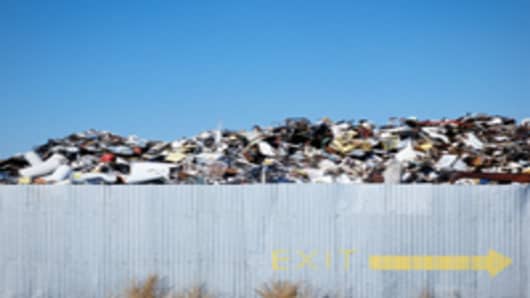If the market in scrap is any indication, the US can recycle the fear of a second recession into a more positive economic outlook.
“Demand is still strong, so as far as a ‘double dip’, forget it,” says Bob Garino, director of commodities for the Institute of Scrap Recycling Industries (ISRI), a scrap industry trade group.
That’s good news for the scrap industry. Like the rest of the economy, prices for scrap products—from metals and plastics, to cardboard and paper—tanked in the current recession.
“In the end, it is a commodity business and it’s very global,” says Rich Abramowitz, director of public affairs at Waste Management, whose firm has a scrap brokerage group with global reach. “It’s like pork bellies.”
The industry estimates revenues fell from $85 billion in 2008 to $70 billion in 2009. “The economic earthquake of 2008 brought startling price corrections for many metals and paper,” says Garino. “Some prices (were) free-falling 40 percent.”
With a domestic rebound in the manufacturing sector and growth in developing economies firming up commodity prices, Garino says that while scrap prices still aren’t back to pre-bust levels across the board, growth should continue through this year.
But the consumer continues to lag, and that’s a concern to the scrap industry—not just because consumers make up almost three-quarters of the US economy, but because post-consumer scrap makes up a big part of their resources.
Groups, Grades and Codes
It’s this reliance on closing the product lifecycle loop that forces dealers to specialize, increasing scrap price volatility as the dealer becomes more captive to both suppliers and buyers.
“It’s a very fragmented market, from the little scrap dealer to large companies like ourselves,” says Waste Management’s Abramowitz. “Each (buyer) gets to set standards to their needs.”
That makes for a dizzying number of categories of scrap.
ISRI breaks it down into five basic groups: ferrous metals, non-ferrous metals, glass, plastic, and paper stock.
But beneath that are dozens of grades, with code names to allow for precise definition—by composition, weight, contamination, packaging and so on—meant to simplify transactions.
These code names are reminiscent of the Cold War names NATO forces once gave to Soviet aircraft. For example, No. 2 copper wire scrap is code-named “Birch.” That same wire with insulation attached is called “Druid.”
This allows some commoditization of scrap and makes for easier comparisons to the qualities of virgin materials. But it puts the buyer in the driver’s seat, even in a “seller’s market” for commodities, by allowing that buyer to demand specific quality for the best prices.
That also creates an incentive for the nation’s 5,000 scrap dealers to keep materials on hand, so they can generate a premium if someone demands a “cleaner” grade material—if someone is will pay to pay extra for “Birch” than “Druid,” for example.
“He has traditionally been long, he is the risk-taker,” says Garino of the typical scrap dealer, adding that “he is always the price-taker,” since he’ll never be able to be a big enough piece of the market to dictate pricing.
But while a copper mining company could announce the discovery of a massive new ore seam and put off mining it until prices recover, with little cost of “storage,” scrap dealers can’t stockpile scrap forever.
They could run afoul of local environmental laws by storing materials, and scrap commodities like plastics and paper can get discounted with age, like stale baked goods. Despite this, thousands of tons of scrap material have been warehoused during the downturn, according to ISRI.
Cash for Clunkers Effect
They can also be more policy sensitive than mining firms. While scrap dealers and miners both face the risk of environmental crackdowns, scrap dealers also need to contend with the unintended consequences of other government action.
For example, DC-based environmental group Earth Policy Institute claims that more automobiles were scrapped than purchased in 2009 due to the “Cash For Clunkers” program, a first since the rationing of World War II.
While that meant lean times for auto dealers, they also faced reduced competition as manufacturers closed dealerships. For auto recyclers, it meant overflowing wrecking yards of supply crashing head-on into stuffed car lots of demand.
But aside from a general economic rebound, there are other bright spots, says ISRI spokesman Mark Neuville. He points to plastics, where scrap dealer knowledge could allow them to command better prices in the future.
“It’s a very complicated process (to recycle plastics),” he says. “That’s one of the untapped areas that’s going to see a lot of growth.
While Garino says there is a high correlation in price movement between scrap commodity prices and their virgin counterparts, relative volatility of scrap prices should also come down as it makes up a larger piece of the raw materials pie.
ISRI’s Neuville says scrap currently makes up about 40 percent of all raw materials used, with the remaining 60 percent from virgin sources, so as scrap moves closer to “resource parity,” expect price stability and parity to follow.
With improved sourcing, sorting and processing, scrap dealers are getting better at knowing “exactly what they’re buying,” he says, adding that “you’re not necessarily going to get a better product if it’s virgin.”
Garino points out this growing fungibility between recycled and virgin resources is the key difference between what policymakers, activists and society as a whole often still calls “waste” —and what his industry adamantly calls “scrap.”
“Don’t intermingle them—waste is destined to be disposed, scrap is destined to be recycled,” he says about those two terms. “Scrap is a commodity, it freely trades and it’s used domestically and internationally.”
On Wednesday, September 29 at 9pm ET/PT, CNBC presents “Trash Inc: The Secret Life of Garbage,”a CNBC Original reported by Carl Quintanilla that takes an inside look at what happens to our garbage after we throw it out—where it goes, who touches it, and who makes money.




